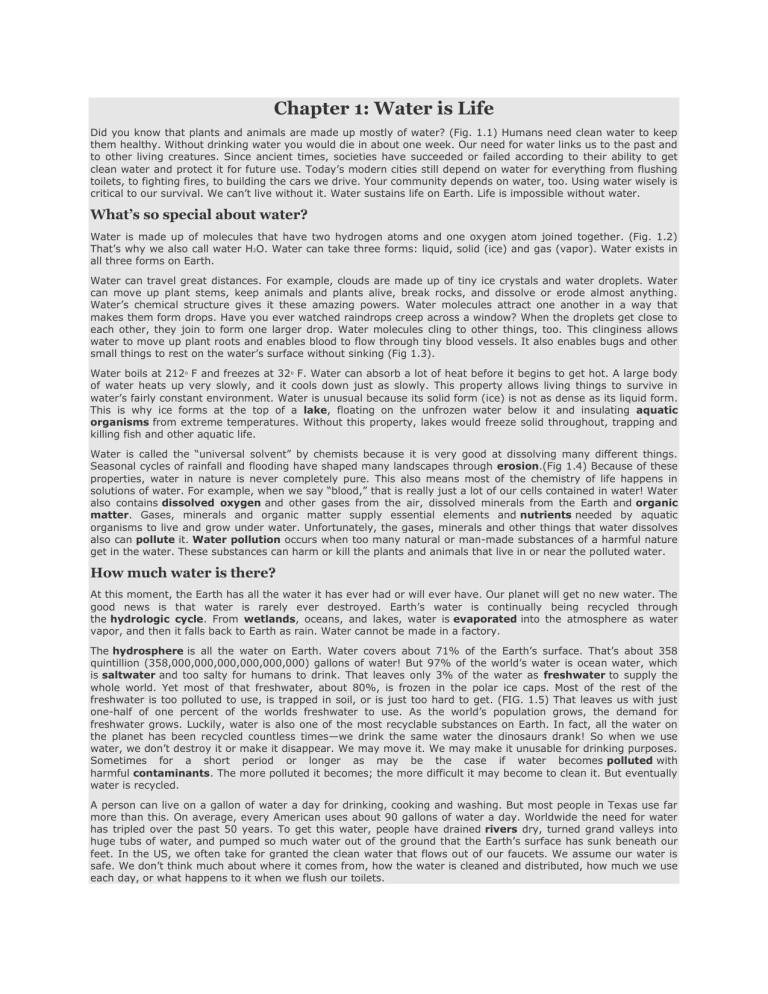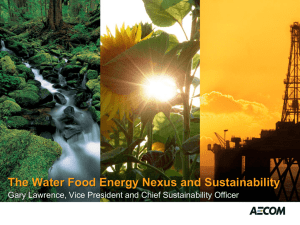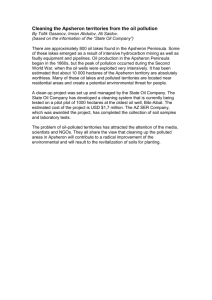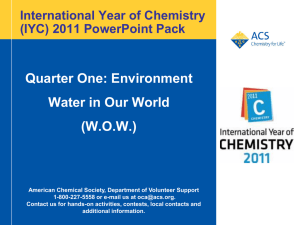Chapter 1: Water is Life

Chapter 1: Water is Life
Did you know that plants and animals are made up mostly of water? (Fig. 1.1) Humans need clean water to keep them healthy. Without drinking water you would die in about one week. Our need for water links us to the past and to other living creatures. Since ancient times, societies have succeeded or failed according to their ability to get clean water and protect it for future use. Today’s modern cities still depend on water for everything from flushing toilets, to fighting fires, to building the cars we drive. Your community depends on water, too. Using water wisely is critical to our survival. We can’t live without it. Water sustains life on Earth. Life is impossible without water.
What’s so special about water?
Water is made up of molecules that have two hydrogen atoms and one oxygen atom joined together. (Fig. 1.2)
That’s why we also call water H
2
O. Water can take three forms: liquid, solid (ice) and gas (vapor). Water exists in all three forms on Earth.
Water can travel great distances. For example, clouds are made up of tiny ice crystals and water droplets. Water can move up plant stems, keep animals and plants alive, break rocks, and dissolve or erode almost anything.
Water’s chemical structure gives it these amazing powers. Water molecules attract one another in a way that makes them form drops. Have you ever watched raindrops creep across a window? When the droplets get close to each other, they join to form one larger drop. Water molecules cling to other things, too. This clinginess allows water to move up plant roots and enables blood to flow through tiny blood vessels. It also enables bugs and other small things to rest on the water’s surface without sinking (Fig 1.3).
Water boils at 212 o
F and freezes at 32 o
F. Water can absorb a lot of heat before it begins to get hot. A large body of water heats up very slowly, and it cools down just as slowly. This property allows living things to survive in water’s fairly constant environment. Water is unusual because its solid form (ice) is not as dense as its liquid form.
This is why ice forms at the top of a lake, floating on the unfrozen water below it and insulating aquatic
organisms from extreme temperatures. Without this property, lakes would freeze solid throughout, trapping and killing fish and other aquatic life.
Water is called the “universal solvent” by chemists because it is very good at dissolving many different things.
Seasonal cycles of rainfall and flooding have shaped many landscapes through erosion.(Fig 1.4) Because of these properties, water in nature is never completely pure. This also means most of the chemistry of life happens in solutions of water. For example, when we say “blood,” that is really just a lot of our cells contained in water! Water also contains dissolved oxygen and other gases from the air, dissolved minerals from the Earth and organic
matter. Gases, minerals and organic matter supply essential elements and nutrients needed by aquatic organisms to live and grow under water. Unfortunately, the gases, minerals and other things that water dissolves also can pollute it. Water pollution occurs when too many natural or man-made substances of a harmful nature get in the water. These substances can harm or kill the plants and animals that live in or near the polluted water.
How much water is there?
At this moment, the Earth has all the water it has ever had or will ever have. Our planet will get no new water. The good news is that water is rarely ever destroyed. Earth’s water is continually being recycled through the hydrologic cycle. From wetlands, oceans, and lakes, water is evaporated into the atmosphere as water vapor, and then it falls back to Earth as rain. Water cannot be made in a factory.
The hydrosphere is all the water on Earth. Water covers about 71% of the Earth’s surface. That’s about 358 quintillion (358,000,000,000,000,000,000) gallons of water! But 97% of the world’s water is ocean water, which is saltwater and too salty for humans to drink. That leaves only 3% of the water as freshwater to supply the whole world. Yet most of that freshwater, about 80%, is frozen in the polar ice caps. Most of the rest of the freshwater is too polluted to use, is trapped in soil, or is just too hard to get. (FIG. 1.5) That leaves us with just one-half of one percent of the worlds freshwater to use. As the world’s population grows, the demand for freshwater grows. Luckily, water is also one of the most recyclable substances on Earth. In fact, all the water on the planet has been recycled countless times—we drink the same water the dinosaurs drank! So when we use water, we don’t destroy it or make it disappear. We may move it. We may make it unusable for drinking purposes.
Sometimes for a short period or longer as may be the case if water becomes polluted with harmful contaminants. The more polluted it becomes; the more difficult it may become to clean it. But eventually water is recycled.
A person can live on a gallon of water a day for drinking, cooking and washing. But most people in Texas use far more than this. On average, every American uses about 90 gallons of water a day. Worldwide the need for water has tripled over the past 50 years. To get this water, people have drained rivers dry, turned grand valleys into huge tubs of water, and pumped so much water out of the ground that the Earth’s surface has sunk beneath our feet. In the US, we often take for granted the clean water that flows out of our faucets. We assume our water is safe. We don’t think much about where it comes from, how the water is cleaned and distributed, how much we use each day, or what happens to it when we flush our toilets.
Waste not, want not
Compared to many countries, the US is water rich. We have 39 million surface acres of lakes and reservoirs. The
Great Lakes cover about 6.7 million acres and contain about one-fifth of the world’s freshwater supply. Water covers about 4% of the US. This abundance has allowed the US to grow surplus crops and build profitable industries. Everyone uses water, but it may surprise you to learn that only about one-tenth of the water used goes to our homes and cities.
Agriculture is the biggest user of water. (FIG 1.6) For example, it takes about 24 gallons of water to grow one pound of potatoes. To produce one pound of beef takes about 2,600 gallons of water. Growing a day’s food for one adult takes about 1,700 gallons of water. The second biggest use of water is for industry. Producing electrical power takes more water than any other industrial use, but almost all the water used is returned to or never removed from where it came from. Moving water where we want it to go actually uses power, too. Approximately
4% of the nation’s electricity is used just for moving and treating drinking water and wastewater. And, did you know that it takes 3,000 to 6,000 gallons of water each year to power one 60-watt light bulb for 12 hours each day for a year?
Water in Texas
Water is the most important natural resource in Texas. We rely on water found on the surface and underground..
Texas has over 1.26 million acres of freshwater in lakes, ponds and reservoirs. There are an additional 2.1 million acres of water in the bays and estuaries along the Texas coast. There is still more water in Texas’ 191,000 miles of streams. Texas is second only to Minnesota in the surface area of lakes and reservoirs and second only to
Alaska in total volume of freshwater. Over three-quarters of the state sets over an enormous underground aquifer. Texas bubbles with about 3,000 springs, including some of the largest in America. Texas is also unique in not having just one or two large rivers like most states. We have over 3,700 streams that feed into
15 large river systems. Texas’ rivers provide water for our personal use, agriculture, communities, recreation.
Transportation, industry, and fish and wildlife. (FIG. 1.7)
If Texas is so rich in water, why should we be concerned about its conservation? The answer is that some parts of the state are water rich while other parts have very little water and can be affected by drought. For example, south and west Texas can be very dry, even when other parts of the state may be very wet. El Paso on the extreme western edge of the state is part of the Chihuahua Desert and usually receives less than 10 inches of rain per year. While Port Arthur is on the eastern edge and can receive more than 60 inches of rain per year.
Most of Texas has modest rainfall compared to the rest of the country. Several years of low rainfall can leave entire parts of Texas without water. In addition people can cause harm to the water in lakes and rivers by pollution and careless use. This in turn harms aquatic resources, such as fish, and can make water undrinkable and useless for recreation. To protect our aquatic resources, we must use them wisely. Conservation means careful use. That is what this book is all about.
Pollution kills
Pure water is clear and transparent to light. As long as water is relatively clear, plants can live under the water, using energy from sunlight passing through the water to make food through photosynthesis. Sometimes water can be discolored from small amounts of natural organic matter in the water. This water may not be polluted. It can be transparent enough to allow light to penetrate. But, this same organic matter that may discolor water at low levels may become harmful to aquatic life at high levels. “Dirty” looking water may be polluted or just dirty. Turbid water contains suspended material, such as dirt, silt, or mud particles. Few plants grow in muddy water because the silt absorbs light. And to make seeing pollution in water even more complicated, not all clear water is clean.
Water may look clean but still be polluted. A body of water may have invisible toxic (poisonous) chemicals in it.
Most toxic pollution comes from man-made chemicals that enter water, such as herbicides, pesticides and industrial compounds. Another kind of pollution we can’t see is too much heat. Water picks up oxygen from the air, when air gets mixed in with water. This is called aeration. You may have seen aerators on aquariums that force air bubbles into water. In nature, flowing water and waves at the water’s surface aerate water. This provides dissolved
oxygen to plants and animals that live in water. Hot water holds less dissolved oxygen than cool water. The plants and animals we see living in water need oxygen, which is dissolved as a gas into the water along with other gases, such as carbon dioxide. If the water level in a lake or stream gets too low and summer heat warms the water too much, fish and other aquatic life do not get the oxygen they need and die.
Pollution can also occur when too much organic matter, such as manure or human sewage, gets in the water and decays. Decaying organic matter uses up a lot of the dissolved oxygen in water. Organic pollution can also happen when inorganic pollutants such as nitrates and phosphates build up in the water. People use nitrates and phosphates as fertilizers on crops, gardens and lawns because these materials help plants grow. High levels of fertilizing chemicals in the water feed the growth of plants and algae. Too many plants growing on the water’s surface can block light from reaching deeper water. Then as plants and algae die and decompose, dissolved
oxygen in the water is quickly used up. This process of rapid plant growth followed by rotting and oxygen loss can result in death of fish and other animals.
Quality water means quality life
The amounts and types of pollution in water affect water quality, which is water’s fitness for a particular use.
Water in a pond or river might not be pure enough to drink without special treatment, but it may be just fine for agriculture or industry, or even for swimming or fishing. Thousands of water samples and tests are performed by water professionals in our communities each year to determine what chemicals and disinfectants must be used to treat raw water to make it suitable for human use. Municipal drinking water is highly regulated in the United States and safe to drink.
Many things affect water quality. Physical properties such as suspended silt and temperature make a big difference.
Chemicals or salts in water also change quality. Water-quality tests are used to measure properties of water, such as acidity and salt level. By measuring water’s ability to conduct electricity, you can tell how much salt and other substances are in the water. Tests can also measure the amount of dissolved oxygen and detect the presence of chemicals such as fertilizers. The presence or absence of plants and animals in a body of water tells a lot about water quality. (Fig. 1.8) If you find a wide variety of healthy aquatic organisms, including plants, insects and fish, you can assume that the water quality is good.
* * *








